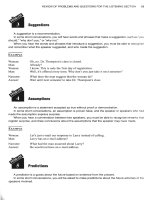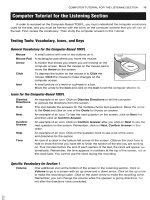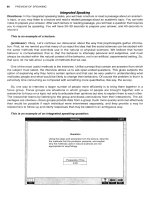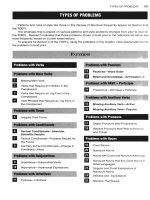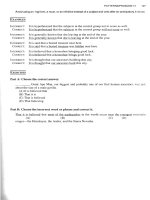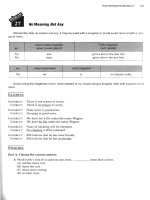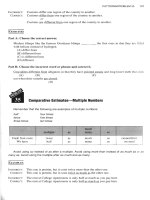Tài liệu How to prepare for the toefl part 10 pptx
Bạn đang xem bản rút gọn của tài liệu. Xem và tải ngay bản đầy đủ của tài liệu tại đây (538.51 KB, 10 trang )
86
PREVIEW
OF
SPEAKING
Integrated Speaking
Directions:
In the integrated speaking tasks, you will hear a lecture or read a passage about an academ-
ic topic, or you may listen to a lecture and read a related passage about an academic topic. You can take
notes to prepare your answer. After each lecture or reading passage, you will hear a question that requires
you to respond by speaking. You will have
20-30
seconds to prepare your answer, and
60
seconds to
record it.
This is an example
of
a lecture:
(professor)
Okay. Let's continue our discussion about
the
way that psychologists gather informa-
tion. First, let me remind you that many of us reject the idea that the social sciences can be studied with
the same methods that scientists use in the natural or physical sciences. We believe that human
behavior is contextualized, that is, that the behavior is intensely personal and subjective, and must
always be studied within the natural context of the behavior, not in an artificial, experimental setting. So,
that said, let me talk about a couple of methods that we use.
One of the most useful methods is the interview. Unlike surveys that contain set answers from which
the subject must select, the interview allows us to ask open-ended questions. This gives subjects the
option of explaining why they hold a certain opinion and that can be very useful in understanding what
motivates people and what would be likely to change their behaviors. Of course the problem is that it is
extremely time consuming as compared with something more quantitative, like say, the survey.
So, one way to interview a larger number of people more efficiently is to bring them together in a
focus group. Focus groups are situations in which groups of people are brought together with a
researcher to focus on a topic not only to articulate their opinions but also to explain them to each other.
The researcher learns by listening to the group and draws conclusions from their interactions. The ad-
vantages are obvious-focus groups provide data from a group much more quickly and cost effectively
than would be possible if each individual were interviewed separately, and they provide a way for
researchers to follow up and clarify responses that may be stated in an ambiguous way.
This is an example of an integrated speaking question:
Question
Using the ideas and examples from the lecture, describe
the methods that the professor presents, and explain
why the methods used in natural sciences are not
appropriate for psychology.
DIRECTIONS AND EXAMPLES FOR SPEAKING QLlESTlONS
87
Here
is an example
of
an answer that receives an excellent rating:
"The methods used to study natural sciences
can't be used to study social sciences because
human behavior is best observed in a real con-
text. In spite of
.
.
.
in spite of the fact that it is
ef-
ficient and relatively . .
.
quick, a survey may be
the least useful method since it uh
. . . it
includes a limited range of answers. On the
other hand, interviews have open-ended ques-
tions, which uh which allow the subjects to
explain the reasons why they answered in a
certain way. But it takes a lot of time to inter-
view an adequate sample. Focus groups allow
researchers to
.
.
.
to gather data from a larger
number of people and uh more quickly than
individual interviews. In a focus group, the
researcher listens to a group and makes
con-
clusions about their opinions uh
.
.
.
following
up and clarifying comments. The way subjects
interact is also interesting to the researcher. So
a focus group is probably the best option for
gathering data."
Checklist for Integrated Speaking
$
The talk answers the topic question.
$
There are only minor inaccuracies in the content.
$
The talk is direct and well-organized.
$
The sentences are logically connected to each other.
$
Details and examples support the main idea.
$
The speaker expresses complete thoughts.
$
The meaning is easy for the listener to comprehend.
@f
A
wide range of vocabulary is used.
$
The speaker paraphrases, using his or her own words.
$
The speaker credits the lecturer with wording when necessary.
$
There are only minor errors in grammar and idioms.
5d
The talk is within a range of
125-1
50 words
88
PREVIEW
OF
SPEAKING
l~itroduced as the
TOEFL
Academic Speaking Test (TAST)
This preview can be used to prepare for the Next Generation TOEFL Speaking Section or the TOEFL
Academic Speaking Test (TAST). The TAST was introduced in 2003 as a first version of the TOEFL
speaking Section. Although minor modifications will be made in the second version of the TAST when it
is included in the Next Generation TOEFL, this preview will be a good way to begin your preparation.
The i~ext Generation TOEFL Speaking Section, like the TAST, will measure your ability to speak in
English about a variety of general and academic topics. There are six questions. The total time is 20
minutes. Although the administration is currently by telephone, the plan is to design a Speaking Section
on the Internet.
There is no Speaking Section on the current format of the Paper-Based TOEFL or the Computer-
Based TOEFL. However, there are plans for a telephone administration of speaking for future Paper-
Based administrations.
Questions like those in this Preview of Speaking appear on the TOEFL Academic Speaking Test,
soon to be reintroduced as the Next Generation TOEFL Speaking Section.
1
Experiences
2
Preferences
3
Reports
4 Examples
5 Problems
6 Summaries
Question
1
-Experiences
In this question, you will be asked to speak about a personal experience. This may be a place, a per-
son, a possession, a situation, or an occasion. After you hear the question, you will make a choice from
your experience and then explain why you made that choice. You will have
15
seconds to prepare and
45 seconds to speak.
Where would you like to study in the United States?
Task
Describe your experience
Explain the reasons for your choice
TYPES
OF
QUESTIONS IN THE SPEAKING SECTION
89
Directions
Read Question
1,
the Example Notes, and the Example Answer. Use the Checklist to learn how to rate
a speaking response for this type of question.
Washington,
D.C.
Family in area-advice, help
International city-food, stores
Tours-sites, trains to other cities
Universities-excellent, accepted at one
SCRIPT
FOR
EXAMPLE
ANSWER
I'd like to study at a university in Washington,
D.C.
because I have family in the area, and . .
.
and it
would be nice to have them close by so I could visit them on holidays and in case I need advice
or
help.
I've been to Washington several times, and I like it there. It's an international city, and there are restau-
rants and stores where I can buy food and other things from my country while uh I'm living abroad.
And
Washington is an exciting place. I've gbne on several tours, but I still have many places on my list
of
sites to see. Also, um . .
.
there are trains to New York and Florida so I could take advantage of my free
time to see other cities in the United States. Um
.
.
.
as for the universities, there are several excellent
schools in Washington, and
.
.
.
and I'd probably be accepted at one of them.
Checklist
V
The talk answers the topic question.
V
The point of view or position is clear.
V
The talk is direct and well-organized.
V
The sentences are logically connected to each other.
V
Details and examples support the main idea.
I/
The speaker expresses complete thoughts.
V
The meaning is easy for the listener to comprehend.
V
A wide range of vocabulary is used.
d
There are only minor errors in grammar.
V
The talk is within a range of
125-1
50
words.
Question 2-Preferences
In this question, you will be asked to speak about a personal preference. This may be a situation, an
activity, or an event. After you hear the question, you will make a choice between two options present-
ed and then explain why you made that choice. You will have
15
seconds to prepare and
45
seconds
to
speak.
Some students live in dormitories on campus. Other students live in apartments off campus.
Which living situation do you think is better and why?
Task
Choose between two options
Explain the reasons for your preference
90
PREVIEW
OF
SPEAKING
Directions
Read Question
2
and the Example Answer. Use the Checklist to learn how to rate a speaking response
for this type of question.
Dormitories
More interaction-practice English, study
Less responsibility-meals, laundry, cleaning
Better location-library, recreation, classroom buildings
A lot of my friends live off campus, but I think that living in a dormitory is a better situation uh especially
for the first year at a new college. Dormitories are structured to provide opportunities for interaction and
for making friends. As a foreign student, it would be an advantage to be in a dormitory to practice
English with other residents and even to find study groups in the dormitory. And dorm students have
.
. .
uh have less responsibility for meals, laundry, and
.
.
.
and cleaning since there are meal plans and
services available as part of the fees. Besides, there's only one check to write, so the bookkeeping's
minimal. And the dormitory offers an ideal location near the library and um all the recreational facilities
and
.
.
.
and classroom buildings.
Checklist
(/
The talk answers the topic question.
(/
The point of view or position is clear.
d
The talk is direct and well-organized.
d
The sentences are logically connected to each other
(/
Details and examples support the main idea.
(/
The speaker expresses complete thoughts.
I/
The meaning is easy for the listener to comprehend.
d
A wide range of vocabulary is used.
d
There are only minor errors in grammar.
(/
The talk is within a range of
125-1
50
words.
Question %Reports
In this question, you will be asked to listen to a speaker and read a short passage on the same topic.
The topic usually involves a campus situation, and the speaker's opinion about it. After you hear the
question, you will be asked to report the speaker's opinion and relate it to the reading passage. You will
have
30
seconds to prepare and
60
seconds to speak.
The man expresses his opinion of the proposal in the announcement. Report his opinion and
ex-
plain the reasons he gives for having that opinion.
Task
Summarize a situation and an opinion about it
Explain the reason or the background
Connect listening and reading passages
TYPES
OF
QUESTIONS IN THE SPEAKING SECTION
91
Directions
Read the Announcement in
45
seconds. Then read the Conversation followed by the Example Answer.
Use the Checklist to learn how to rate a speaking response for this type of question.
Reading
Announcement concerning a proposal for a branch campus
The university is soliciting state and local funding to build a branch campus on the west side
of the city where the 1-19 expressway crosses the 201 loop. This location should provide con-
venient educational opportunities for students who live closer to the new campus as well as for
those students who may choose to live on the west side once the campus is established. The city
plan for the next ten years indicates that there will be major growth near the proposed site,
including housing and shopping areas.
By
building a branch campus, some of the crowding on
the main campus may be resolved.
Talk
I
understand that a branch campus on the city's west side would be convenient for students who live
near the proposed site and might attract more local students, but
I
oppose the plan because it will
redirect funds from the main campus where several classroom buildings need repair. Hanover Hall for
one. And uh a lot of the equipment in the chemistry and physics labs should be replaced. In my lab
classes, we don't do some of the experiments because uh because we don't have enough equipment.
And we need more teachers on the main campus. I'd like to see the branch campus funding allocated
for teachers' salaries in order to decrease the student-teacher ratios. Most of the freshman classes are
huge, and there's very little interaction with professors. Um
. . .
a branch campus would be a good addi-
tion but not until some of the problems on the main campus have been taken care of.
Plans to open a branch campus
Convenient for students near
Might attract more students
But will redirect funds from main campus
Buildings need repair
Equipment should be replaced
More teachers-smaller classes
SCRIPT
FOR
EXAMPLE
ANSWER
The man concedes that the branch campus might be advantageous for students living close to the new
location, but he's concerned that the funding for a branch campus will affect funding on main campus
for
.
. .
for important capital improvements such as classroom buildings that are in need of repair.
Um
.
.
.
and equipment in the science labs is getting old, so it needs to be replaced. And he also points
out that more teachers are needed for the main campus in order to reduce student-teacher ratios, which
.
. . which would improve the quality of the teaching and interaction in classes. So the man feels that
more attention should be given to the main campus and funding should be allocated to improve the
main campus before a branch campus is considered.
92
PREVIEW
OF
SPEAKING
Checklist
d
The talk summarizes the situation and the opinion.
d
The point of view or position is clear.
d
The talk is direct and well-organized.
d
The sentences are logically connected to each other
d
Details and examples support the opinion.
d
The speaker expresses complete thoughts.
(/
The meaning is easy for the listener to comprehend.
d
A wide range of vocabulary is used.
d
There are only minor errors in grammar.
d
The talk is within a range of
125-1
50
words.
In this question, you will be asked to listen to a speaker and read a short passage on the same topic.
The topic usually involves a general concept, and a specific example of it. Sometimes the speaker pro-
vides a contradictory point of view. After you hear the question, you will be asked to explain the exam-
ple and relate it to the concept. You will have
30
seconds to prepare and
60
seconds to speak.
Explain the Wug experiment and why the results supported the basic theory
of
child language
acquisition.
Task
Explain how an example supports a concept
Connect listening and reading passages
Directions
Read the Textbook Passage in
45
seconds. Then read the Lecture followed by the Example Answer.
Use the Checklist to learn how to rate a speaking response for this type of question.
Reading
The telegraphic nature of early sentences in child language is a result of the omission of gram-
matical words such as the article
the
and auxiliary verbs
is
and
are
as well as word endings such
as
-ing,
-ed,
or
-s.
By the end of the third year, these grammatical forms begin to appear in the
speech of most children. It is evident that a great deal of grammatical knowledge is required
before these structures can be used correctly, and errors are commonly observed. The correc-
tion of grammatical errors is a feature of the speech of preschoolers four and five years old. The
study of the errors in child language is interesting because it demonstrates when and how gram-
mar is acquired.
TYPES
OF
QUESTIONS IN
THE
SPEAKING SECTION
93
Lecture
English uses a system of about a dozen word endings to express grammatical meaning-the
-ing
for
present time,
-s
for possession and plurality, and
.
. . the -edfor the past, to mention only a few. But uh
how and when do children learn them? Well, in a classic study by Berko in the 1950s, investigators
.
. .
they elicited a series of forms that required the target endings. For example, a picture was shown of a
bird, and
.
.
.
and the investigator identified it by saying, "This is a Wug." Then the children were shown
two similar birds urn to
. .
.
to elicit the sentence, "There are two
"
So . . . if the children completed
the sentence by saying, "Wugs," then it was inferred that they had learned the -sending. Okay. Essen-
tial to the study was the use of nonsense words like "Wug" since the manipulation of the endings could
have been supported by words that the children
had already heard. In any case, charts were devel-
oped to demonstrate the uh the gradual nature of grammatical acquisition. And the performance
by
chil-
dren from
18
months to four years confirmed the basic theory of child language that the
.
. . the gradual
reduction of grammatical errors
.
.
.
these are evidence of language acquisition.
Word endings grammatical relationships
-ed past
-S
plural
Wug experiment-Berko
nonsense words-not influenced by familiar
manipulate endings
data about development
In English, there are several important word endings that express grammatical relationships, for exam-
ple, the
-ed
ending that signals that the speaker's talking about the past and the -s ending that means
"more than one" uh when it's used at the end of a noun. So, when children learn English, they um
.
.
.
they make errors in these endings, but they gradually refine their use until they master them. In the Wug
experiment, Berko developed nonsense words to get children to use endings
. .
.
so
. . .
so the re-
searchers could uh follow their development. It was important not to use
real
words because the chil-
dren might have been influenced by a word they'd heard before. So this experiment provided data about
the time it takes and the age when endings are learned. It supported the basic theory of child language
that um
.
.
. sorting out grammatical errors is a feature of the speech of
.
.
. of four year olds and a
stage
in language acquisition.
Checklist
d
The talk relates an example to a concept.
d
There are only minor inaccuracies in the content.
d
The talk is direct and well-organized.
d
The sentences are logically connected to each other.
d
Details and examples support the talk.
d
The speaker expresses complete thoughts.
d
The meaning is easy for the listener to comprehend.
d
A
wide range of vocabulary is used.
d
The speaker paraphrases, using his or her own words.
d
The speaker credits the lecturer with wording.
d
There are only minor errors in grammar.
d
The talk is within a range of 125-1 50 words.
94
PREVIEW
OF
SPEAKING
Question 5 Problems
In this question, you will be asked to listen to a conversation and explain a problem and the solutions
that are proposed. You will have
20
seconds to prepare and 60 seconds to speak.
Describe the woman's budgeting problem and the two suggestions that the man makes. What
do you think the woman should do and why?
Task
Describe a problem and several recommendations
Express an opinion about the better solution
Propose an alternative solution
Directions
Read Question
5
and the Example Answer. Then read the Conversation. Use the Checklist to learn how
to rate a speaking response for this type of question.
Conversation
Woman:
Man:
Woman:
Man:
Woman:
Man:
Woman:
Man:
Woman:
Man:
Woman:
Man:
Did your scholarship check come yet?
Yeah, it came last week. Didn't yours?
No. That's the problem. And everything's due at the same time tuition, my dorm fee,
and let's not forget about books.
I
need about
400
dollars just for books.
Well, do you have any money left from last semester, in your checking account, I
mean?
Some, but not nearly enough. The check won't be here until the end of the month, and
I
won't get paid at work for two more weeks
. . .
I don't know what I'm going to do.
How about your credit card? Could you use that?
Maybe, but I'm afraid
I'll
get the credit card bill before I get the scholarship check, then
I'll be in worse trouble because of, you know, the interest rate for the credit card on top
of everything else.
I see your point. Still, the check might come before the credit card bill. You might have
to gamble, unless
. . .
I'm listening.
Well, unless you take out a student loan. A short-term loan. They have them set up at
the Student Credit Union. Isn't that where you have your checking account?
Umhum.
So you could take out a short-term loan and pay it off on the day that you get your
check. It wouldn't cost that much for interest because it would probably be only a few
weeks. That's what I'd do.
Problem-not enough money
Books
Tuition
Dorm
Solutions
Use credit card
Take out a student loan
TYPES OF QUESTIONS
IN
THE SPEAKING SECTION
95
SCRIPT
FOR
EXAMPLE
ANSWER
The woman doesn't have enough money for her expenses. Um .
. .
she has to pay tuition, and her dorm
fee is due at the same time. Besides, she needs to buy books. So the problem is everything has to be
paid now, and she won't get her scholarship check until the end of the month, and she won't be paid at
work for two weeks. The man suggests that she use her credit card because she won't have to pay it
off until the end of the month, but the problem is
. . .
the
. . .
the interest would be substantial if the schol-
arship check is delayed. The other idea-to take out a student loan-that seems better because the
loan could be paid off on the day the check arrives instead of a fixed date, and it wouldn't cost much to
get a short-term loan at the Student Credit Union. So
. .
.
I support applying for a student loan.
Checklist
(/
The talk summarizes the problem and recommendations.
I/
The speaker's point of view or position is clear.
(/
The talk is direct and well-organized.
(/
The sentences are logically connected to each other.
(/
Details and examples support the opinion.
(/
The speaker expresses complete thoughts.
(/
The meaning is easy for the listener to comprehend.
(/
A wide range of vocabulary is used.
(/
There are only minor errors in grammar.
I/
The talk is within a range of 125-1 50 words.
Question 6-41rmmaries
In this question, you will be asked to give a summary of an academic lecture. You will have
20
sec-
onds to prepare and
60
seconds to speak.
EXAMPLE QUESTION
Using examples from the lecture, describe two general types of irrigation systems. Then explain
the disadvantages of each type.
Task
Comprehend part of an academic lecture
Summarize the main points
Directions
Read Question
6,
the Lecture, and the Example Answer. Use the Checklist to learn how to rate a speak-
ing response for this type of question.
Lecture
Two types of irrigation methods that are used worldwide are mentioned in your book. Flood irrigation
. .
.
that has been a method in use since ancient times .
.
. and we still use it today where water is cheap.
Basically, canals connect a water supply like a river or a reservoir to the fields where ditches are
constructed with valves uh valves that allow farmers to siphon water from the canal, sending it down
through the ditches. So that way the field can be totally flooded, or smaller, narrow ditches along the
rows can be filled with water to irrigate the crop. But, this method does have quite a few disadvantages.
Like I said, it's contingent upon cheap water because it isn't very efficient, and the flooding isn't easy to
control,
I
mean, the rows closer to the canal usually receive much more water, and of course, if the field
isn't flat, then the water won't be evenly distributed. Not to mention the cost of building canals and ditch-
es and maintaining the system. So let's consider the alternative-the sprinkler system. In this method
of
